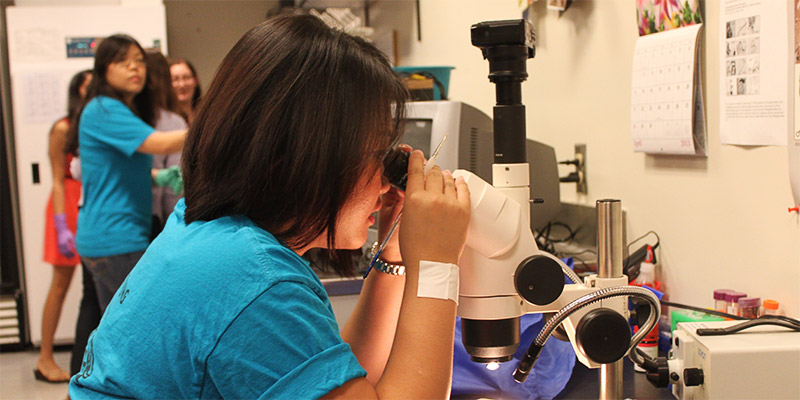Have you ever wondered how it’s possible for a gecko to climb onto the ceiling and stay there? Seems like a good question for a biology course in the W.M. Keck Science Department.
The answer, however, extends beyond biology and into chemistry and physics. Because of this, the question is a perfect example of what is dealt with every semester in Scripps College’s Accelerated Integrated Science Sequence (AISS).
AISS is a cutting-edge, yearlong course designed to combine and integrate all of the principles students would otherwise learn in separate, semester-long introductory courses to biology, chemistry, and physics. Dr. Scot Gould, Dr. Zhaohua Tang, and Dr. Nancy Williams specialize in these subjects, respectively, and work together to teach the class.
While other colleges and universities have created courses that integrate different types of sciences, no other school has a course comparable to AISS in its breadth across all three major scientific disciplines. “It is the only course in the country that links these three,” says Gould.
As interdisciplinary work and thinking is becoming increasingly more prominent in all science, AISS becomes increasingly relevant; scientific interdisciplinary work also reaches far beyond the realm of science itself. When first conceived, the directors contacted 15 of the top medical schools in the country to determine the program’s usefulness for pre-med students. Only one said it would prefer the traditional course track for pre-med applicants. The deeply integrated and comprehensive course material makes AISS a viable foundation for a plethora of science and math-based career paths.
As a single integrated “double course” of two semesters, AISS accelerates students’ progress through a science major and prepares them to move into advanced science courses earlier than if they had taken the separate introductory courses. “I took AISS because I knew I wanted to major in the sciences, but I had no idea what science,” says one Scripps sophomore who completed the course last year. “I realized the other day if I chose to do a biophysics major, I am two-thirds done as a first-semester sophomore. There are 16 required courses, and I have 10 completed, mostly due to AISS.”
Another benefit of completing two semesters of the course is that these students are given preference for National Science Foundation interdisciplinary research fellowships that support research with faculty members during the summer. (AISS is sponsored by the NSF.) Arranging study-abroad opportunities is also easier for science majors who take this course because they have more flexibility in their schedule during the sophomore and junior years.
AISS is taught five days a week by three professors, each focused on his own particular discipline. “If one professor is discussing a topic, the others will say ‘watch this concept, we’ll come back to it later,’ or ‘watch this concept, it’s related to something else,'” says Gould. AISS helps students not only understand the ways in which biology, chemistry, and physics are connected, but how this understanding can solve problems and serve society. For instance, the science behind a gecko’s ability to stand on the ceiling is the same integrated science that is now used in creating bandages for burn victims.
It’s an adjustment of perspective in how we think about science – and it started here at Scripps.


